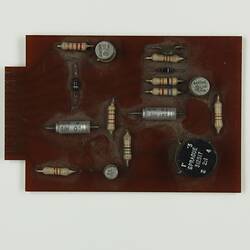Semiconductor Diodes in CSIRAC
The CSIR Mk1/CSIRAC used metal-oxide rectifiers in its power supply and some point contact diodes in its signal circuits. However, vacuum tubes or thermionic valves were used for most of the circuits. The transistor was invented in mid 1948 whilst the CSIR Mk1 was under construction and no transistors were used in the computer as originally built and as displayed at Museum Victoria. Later in the working life of CSIRAC (in 1960?), circuitry was designed and built by Jurij Semkiw to extend the capacity of the magnetic disk store. Low power transistors and simple printed circuit boards were used in the circuits developed to read data from the electro-magnetic read heads. However, due to the high cost of higher power transistors, vacuum tubes were still used for the write circuitry which recorded the magnetic signals onto the disk. This transistor circuitry has survived intact. However, it is not installed in the computer as displayed at Museum Victoria (2006), since the policy is to exhibit the computer as it was in 1956 when it was re-commissioned in Melbourne rather than as it was at the end of its working life.
Early Semiconductor Diodes
Prior to the invention of the transistor, semiconductor devices used in electrical circuits were almost always "two terminal" devices or diodes which enabled current to flow more freely in one direction than the other (it could be argued that the coherer used in very early radio communication was more than a two terminal device, as it enabled a controlling "input" signal to influence a larger "output" signal). Examples were the "crystal" used in crystal sets in which a small wire or cat's whisker made contact with a piece of galena and formed a diode junction at the point of contact.. Much heavier currents could be handled by diodes made by layers of selenium or of copper and copper oxide. These were used to convert alternating current to direct current by limiting current flow to one direction. This process was referred to as "rectification" and the devices were called rectifiers Selenium and copper-oxide rectifiers were frequently used in high current applications such as battery chargers and welders. (Vacuum tube thermionic diodes were also used as rectifiers, for instance in the power supplies domestic radio sets.) By the late 1940s, when CSIRAC was designed and constructed, point contact semiconductor devices (rather like a fixed cat's whisker) based on germanium, were available and could be used for low current applications.
Thermionic Valves
The earliest form of vacuum tubes (invented by John Fleming in 1904) had two electrodes (the anode and the cathode) and were referred to as diodes. More accurately, they were "thermionic diodes". Since electric current could flow in only one direction through them they were also referred to as "valves". Later vacuum tubes, such as "triodes" and "pentodes" had additional electrodes. Signals on one electrode (a grid) could control current flow between a cathode and anode. This enabled amplification, as a small signal potential on the grid could influence a large current between the anode and cathode. However, the term "valve" was still applied to these devices.
More Information
-
Keywords
-
Authors
-
Article types



